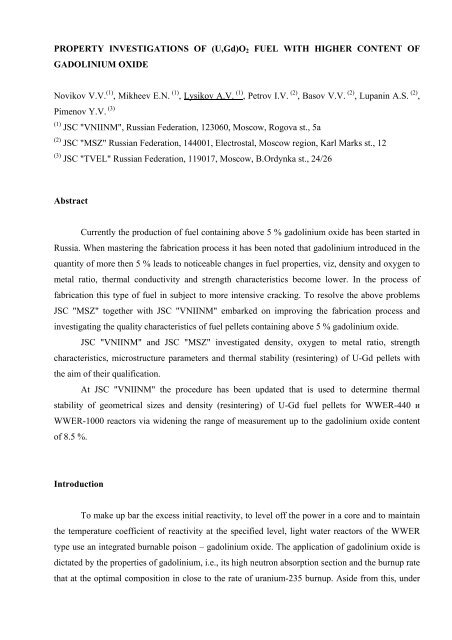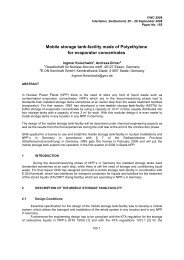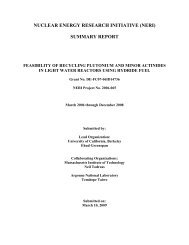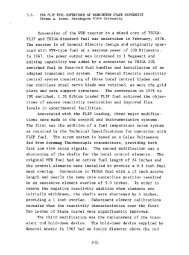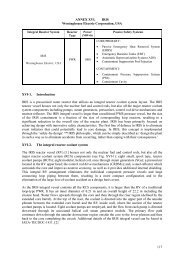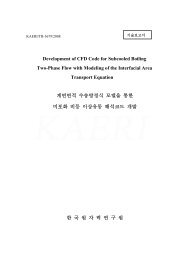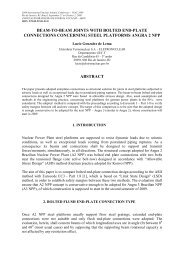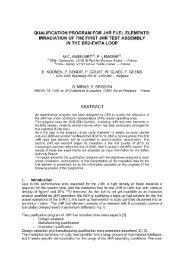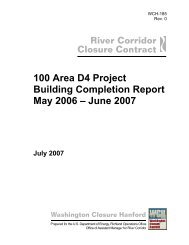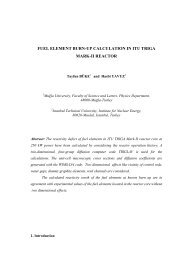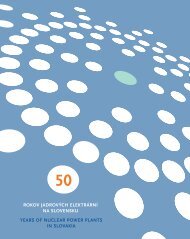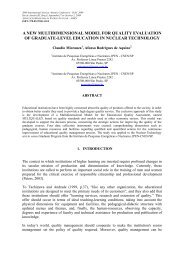(U,Gd)O2 FUEL WITH HIGHER CONTENT OF GADOLINIUM OXIDE ...
(U,Gd)O2 FUEL WITH HIGHER CONTENT OF GADOLINIUM OXIDE ...
(U,Gd)O2 FUEL WITH HIGHER CONTENT OF GADOLINIUM OXIDE ...
You also want an ePaper? Increase the reach of your titles
YUMPU automatically turns print PDFs into web optimized ePapers that Google loves.
PROPERTY INVESTIGATIONS <strong>OF</strong> (U,<strong>Gd</strong>)O 2 <strong>FUEL</strong> <strong>WITH</strong> <strong>HIGHER</strong> <strong>CONTENT</strong> <strong>OF</strong><br />
<strong>GADOLINIUM</strong> <strong>OXIDE</strong><br />
Novikov V.V. (1) , Mikheev E.N. (1) , Lysikov A.V. (1) , Petrov I.V. (2) , Basov V.V. (2) , Lupanin A.S. (2) ,<br />
Pimenov Y.V. (3)<br />
(1) JSC "VNIINM", Russian Federation, 123060, Moscow, Rogova st., 5a<br />
(2) JSC "MSZ" Russian Federation, 144001, Electrostal, Moscow region, Karl Marks st., 12<br />
(3) JSC "TVEL" Russian Federation, 119017, Moscow, B.Ordynka st., 24/26<br />
Abstract<br />
Currently the production of fuel containing above 5 % gadolinium oxide has been started in<br />
Russia. When mastering the fabrication process it has been noted that gadolinium introduced in the<br />
quantity of more then 5 % leads to noticeable changes in fuel properties, viz, density and oxygen to<br />
metal ratio, thermal conductivity and strength characteristics become lower. In the process of<br />
fabrication this type of fuel in subject to more intensive cracking. To resolve the above problems<br />
JSC "MSZ" together with JSC "VNIINM" embarked on improving the fabrication process and<br />
investigating the quality characteristics of fuel pellets containing above 5 % gadolinium oxide.<br />
JSC "VNIINM" and JSC "MSZ" investigated density, oxygen to metal ratio, strength<br />
characteristics, microstructure parameters and thermal stability (resintering) of U-<strong>Gd</strong> pellets with<br />
the aim of their qualification.<br />
At JSC "VNIINM" the procedure has been updated that is used to determine thermal<br />
stability of geometrical sizes and density (resintering) of U-<strong>Gd</strong> fuel pellets for WWER-440 и<br />
WWER-1000 reactors via widening the range of measurement up to the gadolinium oxide content<br />
of 8.5 %.<br />
Introduction<br />
To make up bar the excess initial reactivity, to level off the power in a core and to maintain<br />
the temperature coefficient of reactivity at the specified level, light water reactors of the WWER<br />
type use an integrated burnable poison – gadolinium oxide. The application of gadolinium oxide is<br />
dictated by the properties of gadolinium, i.e., its high neutron absorption section and the burnup rate<br />
that at the optimal composition in close to the rate of uranium-235 burnup. Aside from this, under
2<br />
irradiation of gadolinium no daughter products result that have a high section of thermal neutron<br />
capture while gadolinium oxide and uranium dioxide form solid solutions.<br />
With the current approach to improving the technical and economic NPP parameters via<br />
increasing the nuclear fuel burnup a more efficient suppression of the initial high reactivity is<br />
required. To arrange the suppression the content of a burnable absorber <strong>Gd</strong> 2 O 3 introduced into fuel<br />
has to be more than 5 %. However, from the experience gained in the carried out investigations and<br />
the fabrication of below 5 % <strong>Gd</strong> 2 O 3 containing fuel it is known that the introduction of <strong>Gd</strong> 2 O 3<br />
entails changes in diffusion processes responsible for not only the material densification but also for<br />
the formation of the UO 2 -<strong>Gd</strong> 2 O 3 solid solution [1-3]. The process of the formation of the UO 2 -<br />
<strong>Gd</strong> 2 O 3 solid solution is initiated by the interdiffusion of gadolinium ions into the UO 2 lattice and the<br />
uranium into the <strong>Gd</strong> 2 O 3 lattice. As a result of this interdiffusion the sintering rate decreases and the<br />
densification process is shifted to higher temperatures. The influence of the sintering environment<br />
shows up as different changes in the densities of uranium-gadolinium pellets and uranium dioxide.<br />
Even a little change in the partical pressure of oxygen during sintering may result in an increase of<br />
the UO 2 -<strong>Gd</strong> 2 O 3 solid solution density. The theoretical density of the uranium dioxide-gadolinium<br />
oxide solid solution is lower than that of UO 2 10,96 g/cm 3 and at 10 % of gadolinium oxide<br />
decreases to ~10,63 g/cm3. In this instance the oxygen to metal ratio also changes noticeably. In<br />
practice to calculate the density and the oxygen to metal ratio of U-<strong>Gd</strong> fuel the relationships similar<br />
to (1) and (2) were assumed [4, 5]:<br />
ρu<br />
ρ<br />
g<br />
= ρu<br />
− ⋅ 0, 04 ⋅W<br />
, (1)<br />
ρ<br />
t<br />
K = 2 ,000 + 0, 008W , (2)<br />
where<br />
ρ g is density of U-<strong>Gd</strong> fuel;<br />
ρ u is density of standard UO 2 fuel, from (of) 10,45 to 10,52 g/cm 3 ;<br />
ρ t is theoretical density of UO 2 , 10,96 g/cm 3 ;<br />
K is oxygen to metal ration in U-<strong>Gd</strong> fuel;<br />
W is content of gadolinium oxide, %;<br />
Aside from this, a more than 5 % gadolinium introduction into uranium dioxide leads to<br />
decrease in the thermal conductivity. The increase in the thermal conductivity is related to the fact<br />
that as the content of gadolinium oxide increases the quantity and sizes of pores grow and cracks<br />
appear. The pore formation relates to structural changes in the crystal lattice of fluorite type<br />
uranium dioxide that are effected by introducing gadolinium oxide having the cubic lattice. The
3<br />
thermal conductivity reduction of this type proceeds as the uniformity of the volume distribution of<br />
gadolinium oxide decreases. In its turn, a decrease in the thermal gradients and, thus, to higher<br />
quantities of microcracks. This effect is particularly strong at the <strong>Gd</strong> 2 O 3 content exceeding 5 %<br />
[1,4].<br />
The process used to fabricate U-<strong>Gd</strong> fuel containing below 5 % gadolinium oxide has been<br />
mastered. Besides, in open literature there are sufficient data on the properties of U-<strong>Gd</strong> fuel<br />
containing up to 5 % gadolinium oxide [1-7]. However, the properties of fuel containing more than<br />
5 % gadolinium oxide are studied little [8,9]. For the most part this in explained by the fact that up<br />
to the present time the commercial production of this type of fuel was not a goal. This work is an<br />
attempt to partially make up for the gap.<br />
Investigations<br />
The major properties were investigated at JSC "VNIINM" together with JSC "MSZ" using<br />
laboratory-scale specimens and pellets of pilot batches – produced by JSC "MSZ".<br />
Investigation of density and oxygen to metal ratio<br />
The density of fuel pellets was investigated by the immersion technique. The oxygen to<br />
metal ratio was found by the polarographic method from the transformation of four valence uranium<br />
into six valence one. The results are given in table 1. The same table tabulates of values of density<br />
and oxygen to metal ratio calculated from semiempirical dependences (1) and (2).<br />
Table 1 – Values of density and oxygen to metal ratio<br />
Parameter<br />
Relationship (1) и (2)<br />
Experiment<br />
ρ * g , g/cm 3 К ρ g , g/cm 3 К<br />
<strong>Gd</strong> 2 O 3 , %<br />
1,50 10,46 2,0120 10,52-10,55 2,0126-2,0132<br />
3,35 10,40 2,0268 10,52-10,55 2,0201-2,0227<br />
5 10,33 2,0400 10,50-10,55 2,0302-2,0361<br />
8 10,21 2,0640 10,47-10,54 2,0500-2,0584<br />
10 10,14 2,0800 10,47-10,53 2,0700-2,0767<br />
* For density calculation by relationship (1) ρ u = 10,52 г/см 3 was assumed.<br />
From the data of table 1 it is evident that the semiepirical relationship (1) is not valid. In our<br />
view, this is related to the pellet manufacture process. At the gadolinium oxide content above 5 %
4<br />
oxygen evolved during sintering intensifies diffusion processes, thus increasing the density of the<br />
pellets. At the same time relationship (2) gives adequately exact values of the oxygen to metal ratio<br />
at an increased gadolinium oxide content.<br />
In connection with the revealed difference between theoretically and practically found<br />
densities we have recommended to specify the requirement for the density of uranium-gadolinium<br />
pellets in compliance with the experimentally found data which will allow the provision of the high<br />
uranium loading of a fuel rod and the use of the semiempirical relationship (1) as a reference value<br />
for the lower limit of the density at the specified content of gadolinium oxide.<br />
Investigation in strength characteristics<br />
In compliance with the ASTM requirements C922-00 [9] a pellet loadability test was<br />
performed. For testing three columns of 10 pellets each were used having the gadolinium oxide<br />
contents of 3,35 %, 5,0 %, 8,0 % and 10,0 %. In the experiment it was assumed that all the pellets<br />
had the same density, porosity and grain size. The results are tabulated in table 2 with the<br />
indications of the fracture types: A – a chip of an end face; B – a chip on a face chamfer / an<br />
intersection of a cylindrical surface; C - a chip at pellet cylindrical surface.<br />
It follows from the data of table 2 that at the similar densities, porosity and grain size the<br />
strength of pellets depends of the content of gadolinium oxide and becomes lower with its increase.<br />
Table 2 – Results of investigations for pellet loadability<br />
<strong>Gd</strong> 2 O 3 , % P, kgs Fracture type / quatity<br />
3,35<br />
190 A / 1<br />
305 B / 1<br />
100 B / 1<br />
5<br />
255 C / 1<br />
125 C / 1<br />
60 C / 1<br />
8<br />
225 A /3 , C /1<br />
90 A /1<br />
70 A / 1<br />
10<br />
145 A / 1<br />
70 C / 1<br />
80 B / 1<br />
The influence of grain size on the ultimate strength of U-<strong>Gd</strong> pellets was assessed<br />
qualitatively (figure l) using Griffits modified criterion:<br />
σ = Cd -a , (3)
5<br />
where "C" and "a" are constant determined experimentally; "C" constant accounts for the influence<br />
of other microstructure parameters such as cracks and pore size distribution.<br />
210<br />
200<br />
Ultimate strength, MPa<br />
190<br />
180<br />
170<br />
160<br />
150<br />
5 10 15 20 25 30<br />
Grain size, µm<br />
Figure 1 – U-<strong>Gd</strong> fuel ultimate strength vs grain size<br />
Proceeding from the results of the microstructure examinations this estimation assumed that<br />
"C" constant was similar for the investigated compositions of the U-<strong>Gd</strong> fuel. This assumption<br />
allowed the qualitative assessment of the effect of grain size on the strength of a fuel pellet.<br />
The results of assessing the influence effected by grain size on ultimate strength might be<br />
described by the following dependence:<br />
σ = 266d -0,13(-0,16) . (4)<br />
As it might be seen from figure 1 the "a" exponent is in the range of 0,13-0,16. That is the<br />
acquired results evidence a very weak dependence of the fuel pellet strength on the mean grain size.<br />
This fact corroborates the conclusion that the strength of fuel pellets depends to a greater extent on<br />
the quantity of introduced gadolinium oxide, the method used to prepare initial powder, changes in<br />
the fabrication process conditions, porosity of pellets, phase distribution and grinding.<br />
Investigation of pellet thermal conductivity<br />
The thermal conductivity was investigated using fuel samples containing 5 %, 8 %<br />
gadolinium oxide by laser flash method (Parker impulse method [4]) that consist in measuring the<br />
time interval during which a thermal energy pulse passes through a thin sample (thin discs in our
6<br />
case). The currently acquired and previous data obtained for the 10 % content of gadolinium oxide<br />
were generalized and presented in figure 2. All the data are normalized as applied to the density of<br />
95 % of theoretical via Maxwell-Eiken modified ratio [4].<br />
The presented data comply with theoretical concepts and experimental data on a thermal<br />
conductivity decrease with an increase of the gadolinium oxide content. Thus, they evidence the<br />
needed updating of the process operations used to fabricate fuel containing more than 5 %<br />
gadolinium oxide.<br />
4<br />
3,5<br />
3<br />
♦ - 5 % <strong>Gd</strong> 2 O 3<br />
- 8 % <strong>Gd</strong> 2 O 3<br />
- 10 % <strong>Gd</strong> 2 O 3<br />
λ, W/(mK)<br />
2,5<br />
2<br />
1,5<br />
1<br />
700 800 900 1000 1100<br />
T, K<br />
Figure 2 – Thermal conductivity coefficient of U-<strong>Gd</strong> fuel having different contents of gadolinium oxide<br />
Thermal stability investigations of U-<strong>Gd</strong> fuel<br />
The important parameter of fuel pellets is their thermal stability (resintering). This parameter<br />
affects changes in the pellet geometry (swelling, shrinkage) under irradiation. Previously with the<br />
introduction of up to 5 % gadolinium oxide the test for resintering did not require the introduction<br />
of any special distinctions from the investigations of fuel that did not contain any burnable<br />
absorber. However, at the gadolinium oxide content above 5 % the applied method results in a<br />
significant error. This is explained by the fact that the high temperature thermal treatment of pellets<br />
to determine their resintering usually results in noticeable changes in the oxygen to metal ratio. The<br />
changed oxygen to metal ratio substantially affects the parameter of the (U,<strong>Gd</strong>)O 2 solid solution<br />
crystal lattice. Correspondingly, the reduction leads to an increase in the diameter while the<br />
oxidation results in a decrease in the diameter independent whether pellet resintering takes place or<br />
does not. At low temperatures (not higher than 1400 o C) resintering in as a rule insignificant. In this
7<br />
case dimensions changes are basically effected by a change in the crystal lattice parameter.<br />
Dimensional (diameter) changes might be comparable to changes due to the subsequent high<br />
temperature sintering. To account for the influence effected by the inherent resintering one has to<br />
exclude the influence produced by the changes in a diameter (and density) due to oxidation or<br />
reduction processes, i.e., to determine diametral changes after the high temperature thermal<br />
treatment at the value of the oxygen to metal ratio of the particular pellet that is equal to the<br />
respective initial value. On the basis of the results of the carried out investigations the corrections<br />
factor was suggested that takes into account the changes in the crystal lattice. The introduction of<br />
such a factor provides for the reliable results on the resintering of U-<strong>Gd</strong> fuel.<br />
At JSC "VNIINM" the procedure has been updated that is used to determine the thermal<br />
stability of the geometrical sizes and density (resintering) of fuel pellets of UO 2 containing up to 8,5<br />
% mass fraction of gadolinium oxide as applied to WWER-440 and WWER-1000. The error has<br />
been calculated of determining resintering from a change in the outer diameter ∆D/D for the<br />
resintering range from minus 0,1 % abs. to plus 1,8 % abs. at the confidence level of 0,95.<br />
Investigation of pellets microstructure parameters.<br />
In the fabrication of gadolinium oxide fuel its microstructure parameters were investigated.<br />
The attention was basically placed on its grain sizes, phase composition and the availability and size<br />
of cracks.<br />
The grain sizes, phase composition and available cracks were analyzed metallografically.<br />
All the specimens containing 3,35 %, 5,0 %, 8,0 % and 10,0 % gadolinium oxide were fabricated<br />
using the same process parameters. The results of the investigations are illustrated by figures 3 and<br />
4. The results of examining the phase compositions have revealed that 8,0 % and a higher content of<br />
gadolinium oxide leads to the complete formation of the uranium dioxide – gadolinium oxide solid<br />
solution. At the gadolinium oxide content of 10 % the fraction of the area taken up by the solid<br />
solution is 100 %.<br />
It is evident from the presented data that if the conditions of fabricating fuel having up to 5,0<br />
% gadolinium oxide are used for a higher oxide content then via the oxygen released during<br />
sintering the diffusion processes are intensified with the resultant growth of grain size and the 100<br />
% formation of the solution takes place. However, in this case due to thermal gradients pellets are<br />
subject to intensive cracking (figures 4a and 4 b). Hence, the fuel pellet manufacture conditions<br />
need be corrected. The correction of the fuel process will reduce the formation of cracks in fuel<br />
(figure 4c).
8<br />
Figure 3 – Grain structure of U – 10 % <strong>Gd</strong> 2 O 3 pellets<br />
cracks<br />
homogeneous microstructure (none cracks)<br />
fabrications process updating<br />
Figure 4 – Microstructure of U – 10 % <strong>Gd</strong> 2 O 3 pellets
Commercial optimization of fuel containing above 5 % gadolinium oxide<br />
9<br />
Under the standard conditions the laboratory scale manufactured as well as semicommercially<br />
produced fuel pellets containing above 5,0 % gadolinium oxide have a large quantity<br />
of chips, cracks and microcracks. The pictures of the pellet microstructures before and after<br />
updating the technologic process are illustrated in figure 4.<br />
The analysis has revealed that the appearance of defects is caused by thermal gradients that<br />
are affected by adding gadolinium oxide in the quantity more than 5,0 % and lead to a thermal<br />
resistance increase and a thermal conductivity decrease, hence, to a more intensive formation of<br />
cracks. As it follows from the powder metallurgy practice upon gross alloying with materials that<br />
have properties noticeable different from those of the basic component one has to ensure smooth<br />
thermal loads. Joining into account the results of the start up of the production, the acquired<br />
experimental results as well as the powder metallurgy practice the following proposals were made<br />
on the optimization of the process operations.<br />
JSC "MSZ" together with JSC "VNIINM" have updated the process operations used to<br />
manufacture fuel pellets containing above 5 % gadolinium oxide. In this way the production of the<br />
pellets was ensured that met are the requirement placed by the customer. JSC "MSZ" has produced<br />
a pilot batch of fuel pellets containing 8 % gadolinium oxide. It was delivered to NPP for the trialcommercial<br />
operation.
Conclusions<br />
The implemented comparison of the theoretical dependences of fuel density the oxygen to<br />
metal ration to the experimentally acquired data has shown that:<br />
− in comparison to the semiempiric requirement a more rigid requirement has to be<br />
established for the density that is ensured by the manufacture process this shall allow a<br />
higher uranium load of a fuel rod and the semiempirical dependence to be used as a<br />
reference value for the lower density range at the specified value of the gadolinium oxide<br />
content;<br />
− the oxygen to metal ratio dependence rather will agrees with the experiment, i.e., it might be<br />
used for calculating the detail designs of fuel rods.<br />
From the investigations of the a pellet loadability it follows that at the similar densities,<br />
porosities and grain sizes the strength of pellets depends on the content of gadolinium oxide and<br />
becomes lower with its increase. The implemented qualitative assessment of the influence produced<br />
by a grain size on the strength of U-<strong>Gd</strong> pellets corroborates the conclusion that he fuel pellet<br />
strength to a greater extent depends on the quantity of introduced gadolinium oxide, the method<br />
used to prepare the initial powder, changes in the manufacture process conditions, porosity of<br />
pellets, phase distribution, final treatment (grinding), transport operations during manufacture.<br />
The acquired experimental data are consistent with the theoretical concepts and the<br />
experimentally acquired data on a thermal conductivity reduction with an increase in the content of<br />
gadolinium oxide and necessitate corrections to be introduces into design validations upon the<br />
operation of fuel rod.<br />
The results of the investigations of the fuel phase composition have shown that the content<br />
of gadolinium oxide increased to 8,0 % and higher leads to the complete formation of the uranium<br />
dioxide – gadolinium oxide solid solution.<br />
From the results of the microstructure examinations it follows that at the expense of oxygen<br />
realized during sintering the diffusion processes become intensified with the resultant increases in<br />
grain sizes and pellet densities. However, in this case due to thermal gradients pellets are subject to<br />
gross cracking. Thus, to have high quality products the conditions of the fuel pellet manufacture<br />
have to be perfected.<br />
As applied to the fuels of WWER-440 and WWER-1000 JSC "VNIINM" has updated the<br />
procedure used to determine the thermal stability of geometrical sizes and the density (resintering)<br />
of (U,<strong>Gd</strong>)O 2 pellets having the mass fractions of gadolinium oxide from 3,0 % to 8,5 %. The error<br />
of determining the resintering from changes in the outer diameter ∆D/D in the resintering range
11<br />
from minus 0,1 % abs to plus 0,6 % abs and from a change in the density ∆ρ/ρ in the range from<br />
minus 0,3 % abs to plus 1,8 % abs at the confidence level of 0,95 was calculated.<br />
The existent process used to fabricate the U-<strong>Gd</strong> fuel has been updated which allowed the<br />
output of the products that meet all the requirements placed by the customer.<br />
JSC "MSZ" manufactured a pilot batch of fuel pellets containing 8 % gadolinium oxide and<br />
delivered it to NPP for the trial-commercial operation.
References<br />
1 Bibilashvili Yu.K., Godin Yu.G., Mikheev E.N. et al. Investigation of thermal-physical and<br />
mechanical properties of uranium-gadolinium oxide fuel. Preprint IAE-6138/11. Moscow, 1999, 24<br />
P.<br />
2 Bibilashvili Yu.K., Popov S.G., Proselkov V.N. Thermal properties uranium-gadolinium oxide<br />
fuel pellets. Preprint IAE-6139/11.Moscow,1999 – 44 P.<br />
3 Lysikov A.V., Kouleshov A.V., Novikova E.A. Results of thermal-physical and mechanical<br />
property investigations of modified uranium-gadolinium oxide doped fuel. Russian Scientific<br />
Conference«Materials for Nuclear Technics» – 2007, Zvenigorod – P.22<br />
4 Inoue M., Abe K., Sato I. A method for determining an effective porosity correction factor for<br />
thermal conductivity in fast reactor uranium-plutonium oxide fuel pellets // Journal of Nuclear<br />
Materials – 2000, v.281, №1, P.117-128.<br />
5 Une K. Thermal expansion of UO 2 -<strong>Gd</strong> 2 O 3 fuel pellets// Journal of Nuclear Science and<br />
Technology – 1986, v.23, №11 – P.1020-1022.<br />
6 Bibilashvili Yu.K., Kuleshov A.V., Mikheev E.N. et al. Investigation of thermal-physical and<br />
mechanical properties of uranium-gadolinium oxide fuel // In: Proc. of IAEA Technical Committee<br />
Meeting on Improved Fuel Pellet Materials and Designs – 20-24 October 2003, Brussels, Belgium .<br />
IAEA-TECDOC-1416 – P.85-100.<br />
7 Kolyadin V.I. The thermal conductivity of the uranium dioxide. Preprint IAE-2227, Moscow,<br />
1972, 28 P.<br />
8 Reshetnikov F.G., Bibilashvili Yu.K., Mikheev E.N. et al. Nuclear fuel pellets// RF Patent №<br />
RU 2193242 C2 – 2002.<br />
9 ASTM C922-00 Standard Specification for Sintered Gadolinium Oxide-Uranium Dioxide<br />
Pellets.


